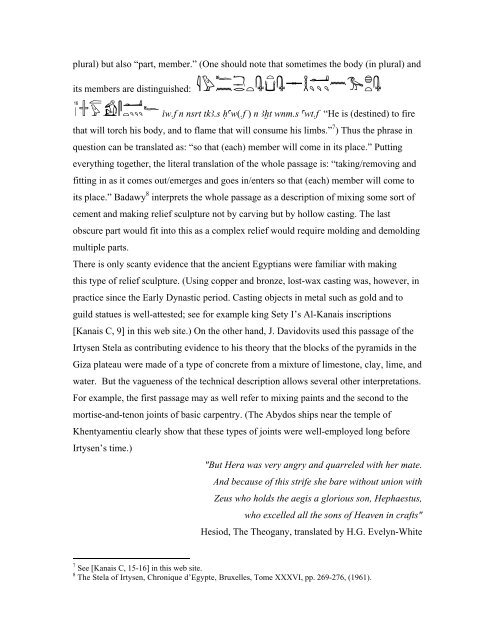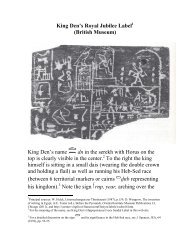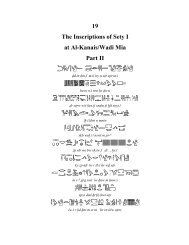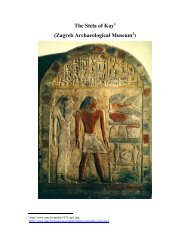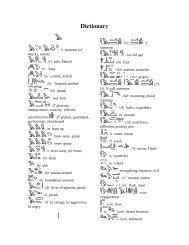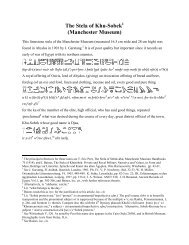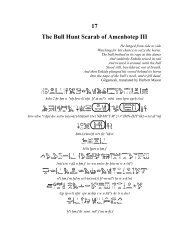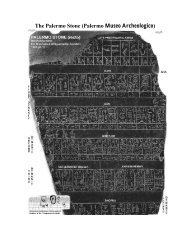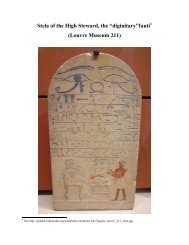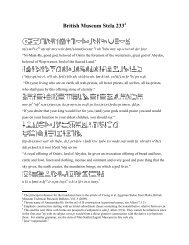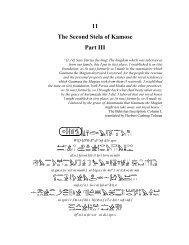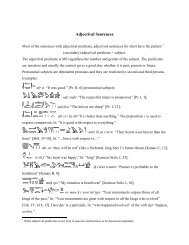7 The Stela of Irtisen - Middle Egyptian Grammar through Literature
7 The Stela of Irtisen - Middle Egyptian Grammar through Literature
7 The Stela of Irtisen - Middle Egyptian Grammar through Literature
Create successful ePaper yourself
Turn your PDF publications into a flip-book with our unique Google optimized e-Paper software.
plural) but also “part, member.” (One should note that sometimes the body (in plural) and<br />
its members are distinguished:<br />
iw.f n nsrt tkA.s Haw(.f ) n Axt wnm.s awt.f “He is (destined) to fire<br />
that will torch his body, and to flame that will consume his limbs.” 7 ) Thus the phrase in<br />
question can be translated as: “so that (each) member will come in its place.” Putting<br />
everything together, the literal translation <strong>of</strong> the whole passage is: “taking/removing and<br />
fitting in as it comes out/emerges and goes in/enters so that (each) member will come to<br />
its place.” Badawy 8 interprets the whole passage as a description <strong>of</strong> mixing some sort <strong>of</strong><br />
cement and making relief sculpture not by carving but by hollow casting. <strong>The</strong> last<br />
obscure part would fit into this as a complex relief would require molding and demolding<br />
multiple parts.<br />
<strong>The</strong>re is only scanty evidence that the ancient <strong>Egyptian</strong>s were familiar with making<br />
this type <strong>of</strong> relief sculpture. (Using copper and bronze, lost-wax casting was, however, in<br />
practice since the Early Dynastic period. Casting objects in metal such as gold and to<br />
guild statues is well-attested; see for example king Sety I’s Al-Kanais inscriptions<br />
[Kanais C, 9] in this web site.) On the other hand, J. Davidovits used this passage <strong>of</strong> the<br />
Irtysen <strong>Stela</strong> as contributing evidence to his theory that the blocks <strong>of</strong> the pyramids in the<br />
Giza plateau were made <strong>of</strong> a type <strong>of</strong> concrete from a mixture <strong>of</strong> limestone, clay, lime, and<br />
water. But the vagueness <strong>of</strong> the technical description allows several other interpretations.<br />
For example, the first passage may as well refer to mixing paints and the second to the<br />
mortise-and-tenon joints <strong>of</strong> basic carpentry. (<strong>The</strong> Abydos ships near the temple <strong>of</strong><br />
Khentyamentiu clearly show that these types <strong>of</strong> joints were well-employed long before<br />
Irtysen’s time.)<br />
"But Hera was very angry and quarreled with her mate.<br />
And because <strong>of</strong> this strife she bare without union with<br />
Zeus who holds the aegis a glorious son, Hephaestus,<br />
who excelled all the sons <strong>of</strong> Heaven in crafts"<br />
Hesiod, <strong>The</strong> <strong>The</strong>ogany, translated by H.G. Evelyn-White<br />
7 See [Kanais C, 15-16] in this web site.<br />
8 <strong>The</strong> <strong>Stela</strong> <strong>of</strong> Irtysen, Chronique d’Egypte, Bruxelles, Tome XXXVI, pp. 269-276, (1961).


